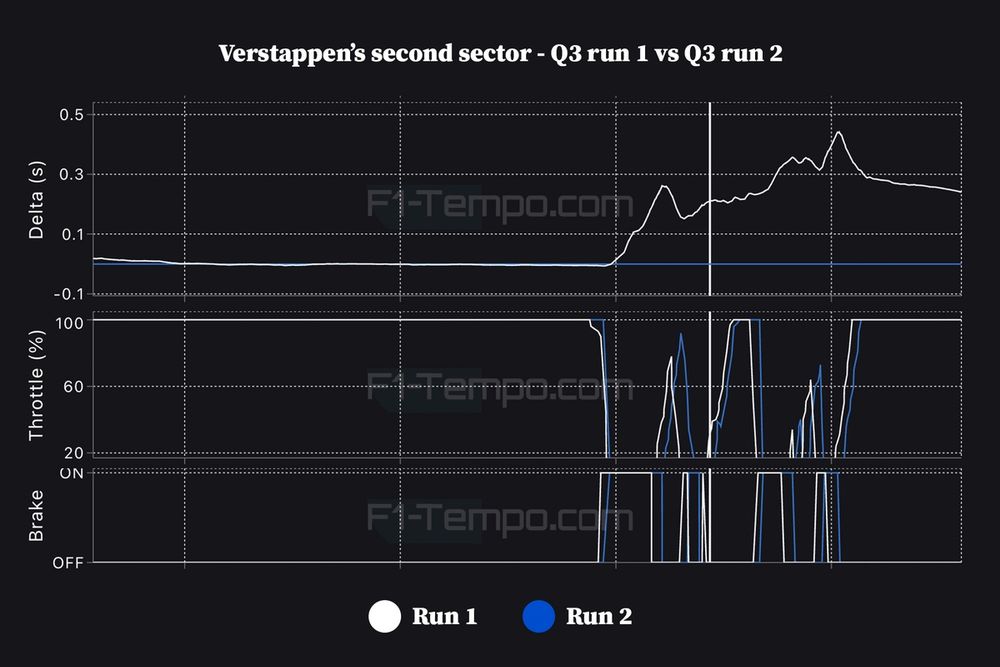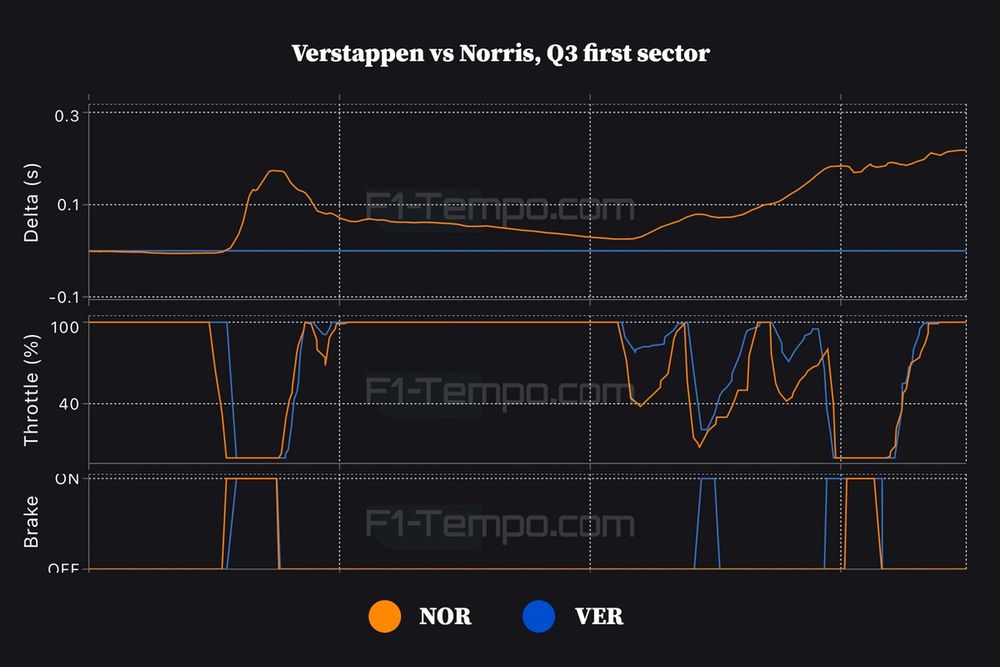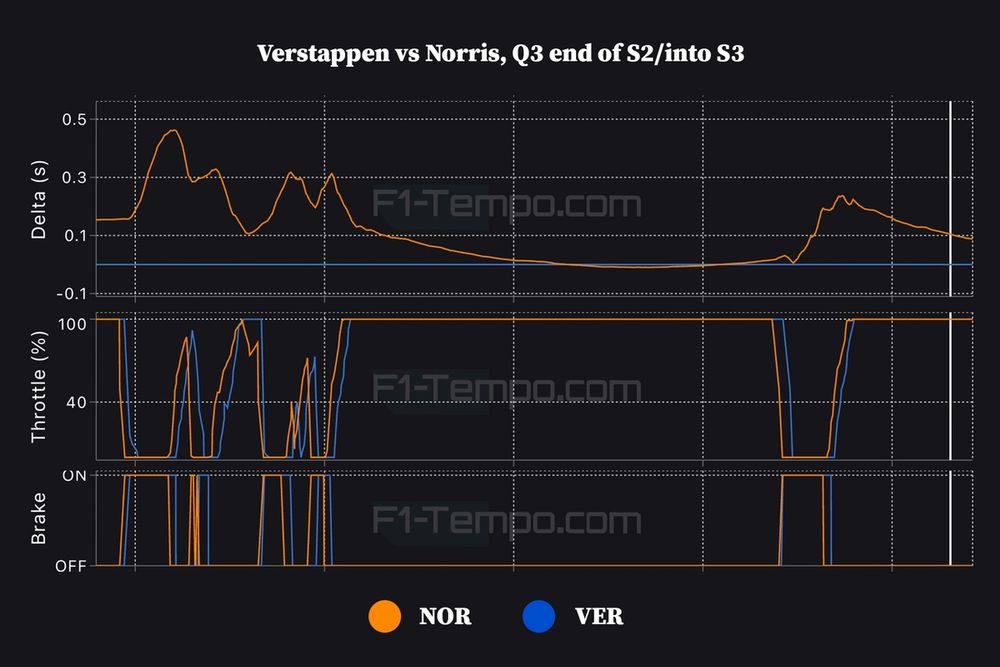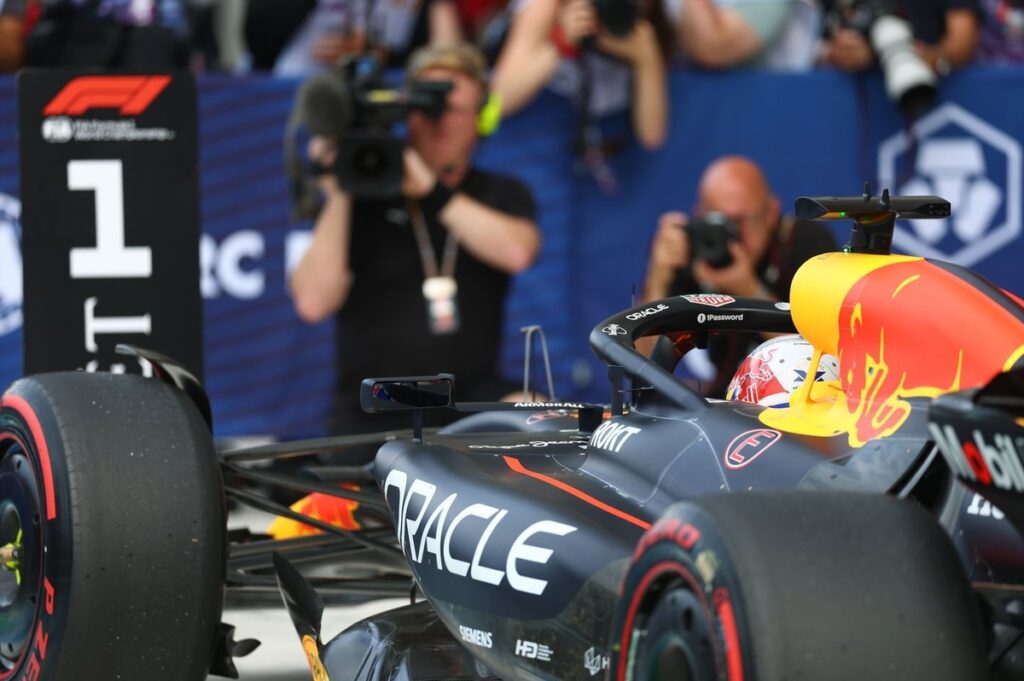A scant 0.065-second margin separated Max Verstappen and Lando Norris in Formula 1 qualifying for the Miami Grand Prix, and there’s two ways that you can interpret that gap depending on the parts of the lap you look at.
The first suggestion is that Norris frittered away his pole hopes with a slightly early turn-in at Turn 17, a move that cut the speed he’d carried through the final corner and unsettled the car enough on the exit to prise open the gap between them.
Alternatively, it could be suggested that Norris had lost pole through the first sector, where Verstappen eked out his biggest advantage through Turns 4 to 8. Both assertions are not mutually exclusive – but at any rate, it was irrelevant; Verstappen put the lap together, and Norris did not.
Verstappen had demonstrated a healthy advantage in the first sector all weekend. Despite the assertions made about the stability of the RB21 this year, it’s shown it has great speed in the high-speed corners as long as a driver can goad the car into complying with their steering inputs. Naturally, this plays to the Dutchman’s strengths – and he’d been able to carry the speed in this area.
Verstappen vs Verstappen
Despite a first-corner mistake, Verstappen was able to find a tiny bit more on his second tour of Q3 over his first in the opening sector. This was entirely down to his exit from Turn 8, as GPS data shows that his first lap was actually more prosperous across most of the opening sector due to that Turn 1 error.
Here, Verstappen stayed on the throttle a moment too long, which resulted in the back end of the car breaking traction slightly to force a correction. The four-time champion was chasing the lap at this point, but he managed to make a lunge forward at the end of the sector after starting on the back foot.
Through the lap data, Verstappen had been able to get onto the throttle earlier on his first Q3 effort sooner, which bought a tenth more time on the exit of that corner. Thus, he’d come out of the corner with more speed; on his second effort, he was taking the high-speed corners at a slightly more glacial pace, and thus was bleeding off the throttle less to compensate and to reduce the lap-time deficit.
Max Verstappen, Red Bull Racing Q3, Sector 1
Photo by: Motorsport Network
Although the Red Bull driver came off the throttle sooner for Turn 7, this was the move that ensured he ended the first sector 0.022s up on his previous best. The traces here – earlier off the throttle, earlier onto the brake – would suggest that he’d be slower, but it was a later change-down from sixth gear to fourth that kept the engine speed up.
By doing this and retarding the engine braking, Verstappen actually ended up carrying more speed into the corner, and he was off the brake very slightly earlier to further limit the deceleration. It was keeping that minimum speed up that ensured he recovered that missing tenth and also reclaimed a smidgen back on reapplying the throttle.
Along the back stretch, Verstappen was pretty much level with his previous lap. Then came another decisive gain on his previous lap by carrying more speed into Turn 11 to push the car to its limits through the hard left-hand stop; this ensured a chain reaction of pulling more speed through Turn 12 and in finding confidence to be more decisive on the throttle.

Max Verstappen, Red Bull Racing Q3, Sector 2
Photo by: Motorsport Network
Ultimately, that won him an extra quarter of a second over his opening run of Q3, an advantage that he carried through the rest of the lap. Hesitance on the throttle on the exit of Turn 17 on his opening lap also conferred an extra half-hundredth by the time he’d crossed the line.
Without that minor blip in the first sector, Verstappen might have been pushing for an extra tenth or so over Norris on his pole lap – nonetheless, it was an exercise in demonstrating why drivers shouldn’t necessarily give up after a relatively small mistake at the start. The time can be recovered.
“We improved the car a tiny amount as well, which helped me to basically rotate it a bit better,” Verstappen reported following his capture of pole. “Honestly, Q1, Q2, Q3, just improving every run really, trying to find a bit more the limit.
“I had a tiny moment on my final lap into Turn 1, so I lost a bit of time there. But around here it’s just very complicated with the tyres over a lap. But in the end it worked out well, so I’m very happy to be on pole.
“I mean you can back out of it, but it’s qualifying so you have to try and correct it, and just floor it out of the corner.”
Verstappen vs Norris
Red Bull entered the weekend with suspicions that Verstappen’s high-mileage engine was going to cut into his straightline speed, particularly when stacked against McLaren’s decision to take a fresh power unit for this round. This is generally evident over the runs through the straights, where the superior McLaren traction out of low-speed corners could also punish the Red Bull set-up a little more.
Norris wasn’t a million miles away at the start of the first sector, but the delta expands significantly when the two get to Turns 4-5-6. The initial jump in the delta is consistent with Verstappen carrying a bit too much speed into Turn 1, and this falls back slightly as Verstappen recovered.

Max Verstappen, Red Bull Racing vs Lando Norris, McLaren, Q3, Sector 1
Photo by: Motorsport Network
Regardless, Norris wasn’t taking as much speed through the opening complex and, as this tends to be a cumulative effect, you see Verstappen’s advantage grow in the opening sector. Norris hadn’t improved on his previous best here, and he was over 0.2s shy of the polewinner at the close of the first sector.
Interestingly, Verstappen chooses to brake slightly into Turn 5, while Norris instead chooses to bleed off the throttle and allow the engine to perhaps take some of the braking load.
Norris stabilises the gap through the straight, and actually cuts a 0.21s disadvantage down to 0.15s – perhaps down to the power losses of Verstappen’s ageing Honda powerplant, or perhaps down to McLaren’s greater efficiency in a straight line. Or both.

Max Verstappen, Red Bull Racing vs Lando Norris, McLaren, Q3, Sector 2-3
Photo by: Motorsport Network
Looking at the end of the second sector and the transition to the final sector, Norris gets a much cleaner exit out of Turn 16 – again, McLaren’s low-speed exit traction coming into play – and slashes the arrears to bring the two neck-and-neck into the final corner.
You can see Norris’ exit is slightly stronger, as he’s on the throttle sooner and briefly dips under Verstappen’s delta. But Norris then makes the decision to come off the throttle sooner into Turn 17, which slows the car too much and allows him to clunk over the apex kerb too much. This unsettles the car; although his acceleration out of the corner is stronger, Norris has lost the time already and he’s simply recovering through the final two turns on the lap.
In this article
Jake Boxall-Legge
Formula 1
Max Verstappen
Be the first to know and subscribe for real-time news email updates on these topics
Subscribe to news alerts
Read the full article here

